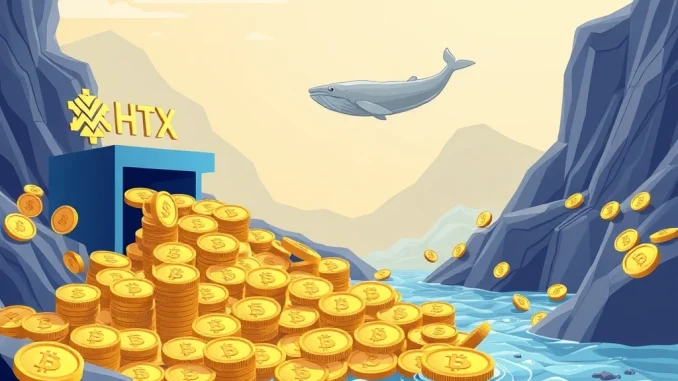
In a move that has sent ripples across the cryptocurrency landscape, Whale Alert, the popular blockchain transaction tracker, recently reported a monumental USDT transfer. A staggering 200,000,000 USDT, valued at approximately $200 million, was observed moving from the HTX exchange to the decentralized lending protocol, Aave. This single transaction, indicative of a significant crypto whale transaction, immediately sparked discussions about market sentiment, liquidity shifts, and the evolving dynamics between centralized exchanges (CEXs) and decentralized finance (DeFi).
What Does This Massive USDT Transfer Signify?
The sheer scale of this USDT transfer is impossible to ignore. Two hundred million dollars is a substantial amount in any financial market, but in the often-volatile crypto space, it speaks volumes. Such large movements typically originate from institutional players, high-net-worth individuals, or even protocol treasuries, often referred to as ‘whales’ due to their ability to influence market conditions.
Understanding the significance requires a look at the involved entities:
- USDT (Tether): As the largest stablecoin by market capitalization, USDT is pegged to the US dollar, making it a crucial bridge between traditional finance and the crypto world. Its stability makes it ideal for large transfers where price volatility is a concern.
- HTX (formerly Huobi): A major global cryptocurrency exchange, HTX serves as a primary gateway for many users to buy, sell, and trade digital assets. Funds held on exchanges are typically for trading, short-term holding, or withdrawal to private wallets.
- Aave: A leading decentralized non-custodial liquidity protocol, Aave allows users to lend and borrow cryptocurrencies. Funds deposited into Aave contribute to liquidity pools, earning interest for lenders and providing collateral for borrowers.
The transfer from a centralized exchange like HTX to a DeFi protocol like Aave suggests a shift in intent for these funds, moving from a trading environment to a utility-driven, interest-earning or collateral-providing one within the DeFi ecosystem.
Why the Move from HTX to Aave? Analyzing the Crypto Whale Transaction
A crypto whale transaction of this magnitude from a CEX to a DeFi protocol isn’t random; it’s a calculated move with several potential motivations. When a large sum like $200 million in USDT moves from HTX to Aave, it signals a strategic decision by the whale. Here are some key reasons:
- Yield Generation: One of the most common reasons to move stablecoins to Aave is to earn passive income. Aave offers attractive interest rates for lending stablecoins, which can be significantly higher than traditional savings accounts. For a $200 million principal, even a modest percentage yield translates into substantial returns.
- Collateral for Borrowing: The whale might intend to use the USDT as collateral to borrow other cryptocurrencies on Aave. This could be for various purposes, such as leveraging a position, shorting an asset, or gaining liquidity without selling their primary crypto holdings.
- Arbitrage Opportunities: Large players constantly look for arbitrage opportunities. Moving funds to Aave might be part of a larger strategy to capitalize on interest rate differentials between various lending platforms or to participate in complex DeFi strategies that require substantial liquidity.
- DeFi Participation and Governance: Some whales are deeply involved in the DeFi ecosystem, participating in governance, providing liquidity to various pools, or interacting with new protocols. Moving funds to Aave could be a step towards broader DeFi engagement.
- Reduced Counterparty Risk (Perceived): While exchanges like HTX are generally secure, some large holders prefer the non-custodial nature of DeFi protocols like Aave, where they retain control of their private keys, thus mitigating perceived counterparty risk associated with centralized entities.
This movement underscores the growing confidence and utility of decentralized platforms for managing substantial digital assets, moving beyond mere speculative trading.
The Impact on Stablecoin Liquidity and DeFi Lending
This USDT transfer directly impacts stablecoin liquidity within the Aave protocol. When $200 million in USDT is deposited into Aave’s liquidity pools, it has several immediate and long-term effects:
- Increased Lending Capacity: More USDT in the pools means more capital available for users to borrow. This can lead to increased activity on the platform and potentially attract more users looking for borrowing opportunities.
- Potential for Lower Borrowing Rates: With increased supply, the interest rates for borrowing USDT on Aave might decrease, making it more attractive for borrowers. Conversely, lending rates might slightly decrease due to the increased supply, though the overall yield can still be compelling.
- Enhanced Protocol Stability: Large deposits of stablecoins like USDT contribute to the overall health and stability of the Aave protocol. It strengthens the collateral base and reduces the risk of liquidity crunches, especially during periods of high market volatility.
- Signaling Confidence in DeFi: A massive injection of funds into Aave from a major exchange is a strong signal of confidence in the DeFi ecosystem. It shows that even large, sophisticated players view decentralized protocols as robust and reliable for managing significant capital.
This influx of capital highlights the dynamic interplay between centralized and decentralized finance, with funds flowing to where they can be most efficiently utilized or generate the best returns.
What Does This Mean for the Future of DeFi Lending?
The continuous flow of significant capital into protocols like Aave is a testament to the maturation and growing appeal of DeFi lending. It indicates that:
- Institutional Adoption is Growing: While this specific whale might be an individual, the sheer size of the transaction suggests a level of sophistication often associated with institutional players or professional funds. Their participation validates DeFi as a legitimate and viable financial frontier.
- Liquidity is Key: For DeFi to truly compete with traditional finance, it needs deep liquidity. Transactions like this one bolster that liquidity, making DeFi protocols more robust and efficient.
- Interoperability is Essential: The seamless movement of assets between CEXs and DeFi protocols highlights the importance of interoperability and user-friendly bridges that facilitate such transfers.
- Risk Management Remains Paramount: While attractive, DeFi lending is not without risks. Smart contract vulnerabilities, impermanent loss, and liquidation risks are factors that whales and retail investors alike must consider. However, the continuous flow of capital suggests that the perceived benefits outweigh these risks for many.
This transaction serves as a strong indicator that the boundaries between traditional crypto trading and decentralized finance are becoming increasingly blurred, with capital flowing freely to optimize returns and utility.
How Do Crypto Whale Transactions Influence the Market?
While a single crypto whale transaction of $200 million in USDT might not directly cause immediate price swings in volatile assets like Bitcoin or Ethereum (since USDT is stable), it can have indirect influences and serve as a market signal:
- Sentiment Indicator: Large stablecoin movements into DeFi can signal bullish sentiment among whales, suggesting they are preparing to engage in DeFi strategies that might involve leveraging or acquiring other assets. Conversely, large movements out of DeFi back to exchanges could indicate an intent to sell or move to fiat.
- Liquidity Shifts: These transactions highlight where significant liquidity is being deployed. If a whale is moving funds into a specific protocol, it indicates confidence in that protocol’s security and yield-generating capabilities.
- Market Structure: The increasing trend of large funds moving into DeFi changes the overall market structure, making decentralized protocols more central to the broader crypto economy. This decentralization of liquidity can have long-term implications for market efficiency and resilience.
- Follow-the-Leader Effect: While not always advisable, some smaller investors might try to ‘front-run’ or ‘follow’ whale movements, believing these large players have superior market insights. This can create short-term volatility or increased activity around certain protocols.
Monitoring these large transactions provides valuable insights into the strategies of major market participants and can offer clues about potential future market trends.
Conclusion: A Glimpse into the Evolving Crypto Landscape
The reported USDT transfer of $200 million from HTX to Aave is far more than just a large transaction; it’s a powerful narrative about the maturation of the crypto ecosystem. It underscores the growing importance of stablecoin liquidity, the increasing confidence in DeFi lending protocols, and the strategic maneuvers of significant players in the market. As the lines between centralized and decentralized finance continue to blur, such massive crypto whale transactions will undoubtedly remain a key indicator for understanding the flow of capital and the future direction of the digital economy. Keeping an eye on these ‘whale alerts’ offers a fascinating glimpse into the strategic depths of the crypto world, highlighting the continuous innovation and adaptation within this rapidly evolving space.
Frequently Asked Questions (FAQs)
Q1: What is a ‘crypto whale transaction’?
A crypto whale transaction refers to a very large cryptocurrency transfer made by an individual or entity (a ‘whale’) holding substantial amounts of crypto. These transactions are significant because they can influence market dynamics, liquidity, and sentiment due to their sheer size.
Q2: Why would someone transfer $200 million in USDT from an exchange to Aave?
The primary reasons for such a large USDT transfer from a centralized exchange like HTX to a DeFi protocol like Aave typically include earning passive income through lending (yield generation), using the USDT as collateral to borrow other cryptocurrencies, participating in complex DeFi strategies, or leveraging perceived lower counterparty risk in decentralized environments.
Q3: How does this USDT transfer affect Aave’s stablecoin liquidity?
A $200 million USDT transfer significantly increases Aave’s stablecoin liquidity. This means there’s more capital available for borrowers, which can lead to lower borrowing interest rates and enhance the overall stability and robustness of the Aave protocol, making it more attractive for both lenders and borrowers.
Q4: Is it safe to move such large amounts of stablecoins in DeFi?
While DeFi offers many benefits, it also carries risks. Smart contract vulnerabilities, impermanent loss in liquidity pools, and liquidation risks are inherent. However, established protocols like Aave undergo rigorous audits, and many large institutions and individuals are increasingly comfortable with the security measures in place, provided they conduct thorough due diligence.
Q5: Can retail investors benefit from tracking these large crypto whale transactions?
Yes, observing large crypto whale transactions can provide insights into market sentiment and potential trends. While it’s not a direct signal to buy or sell, it can indicate where large capital is being deployed, signaling confidence in certain protocols or strategies. However, retail investors should always conduct their own research and not blindly follow whale movements.



